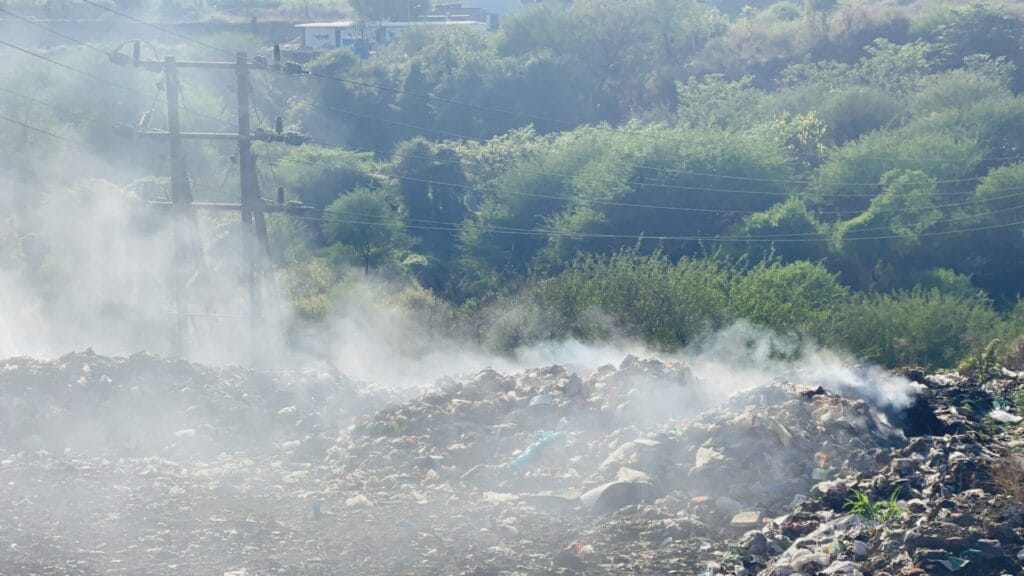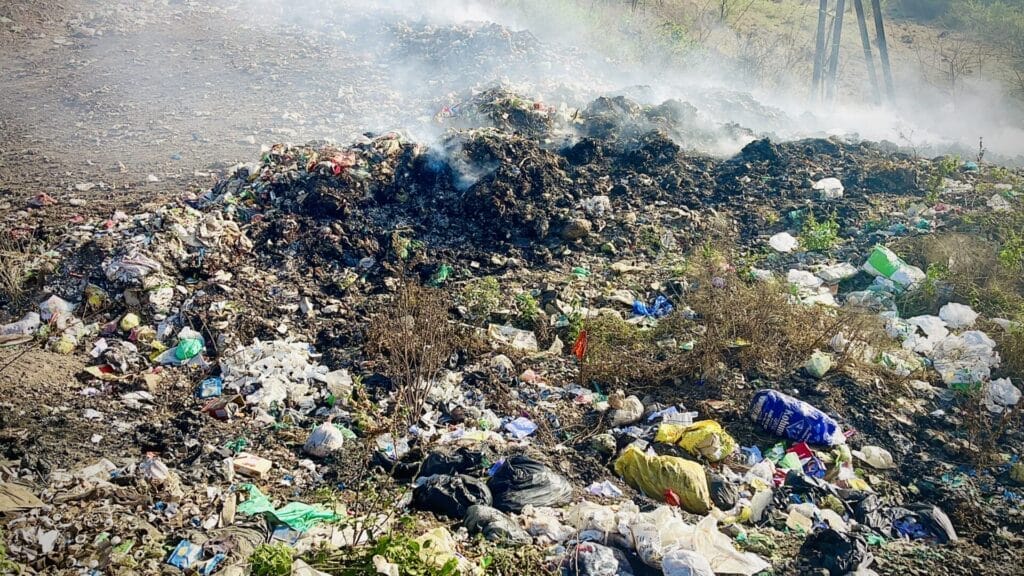Recently, when I drove through Varale-Ambethan Road in Pune, I saw a worrying sight near the Pimpri-Chinchwad industrial area. Piles of garbage lined the roadside, set ablaze in the afternoon sun. The burning garbage consisted of a hazardous mix of chemicals, metals, and food waste.
The air, filled with the pungent smell of burning refuse, was a cocktail of impurities. During my visit, the acrid smoke lingered for at least two hours, permeating the air and infiltrating the air conditioning vents of industries and vehicles passing by. It was difficult to breathe easily while travelling through that road.

Unchecked industrial pollution is one of the major causes of air and water contamination and can lead to long-lasting health implications. It can also add to carbon footprint of a region and worsen the impact of climate change.
Residents and workers affected
On speaking to people in the area, it became clear that this has been happening for several months. It has been impacting the surroundings and more importantly, the health of those living in the nearby areas.
Tanaji S, an industrial worker, speaking during his tea break, said that the garbage had a foul smell, attracting flies and mosquitoes, leading to health problems. Savita Kumari, a daily wage worker, echoed the sentiment. She said, “I find it difficult to breathe because of the smoke after the garbage is set ablaze.”
Read more: Industrial pollution in Chennai: Through the lens of the toxic tour
Apart from workers who spend several hours in the area, commuters who pass through the area, also spoke of the discomfort. Shivraj Nej, a daily commuter, said the smoke enters car’s AC vents and passengers find it difficult to breathe inside vehicles. He said this had been happening for the past few months.
Tejas K, a mechanical engineer in a nearby industry, said the burning of garbage generates unpleasant odours. He added that it also diminishes the quality of life for residents and businesses in the vicinity.
Waste generated from Pimpri-Chinchwad industrial area
Pimpri Chinchwad, known for its lively industrial setting, is a crucial hub in Pune’s economic landscape. It is located 15 km away from Pune city. The industrial area is a mix of traditional and modern manufacturing, playing a big part in the region’s economic growth.
It’s home to various industries and has attracted major players in areas like cars, engineering, and technology. Big national and international companies like Bajaj Auto, Tata Motors, and Thermax have their units in this area.

Varale -Ambethan road is situated in Pimpri Chinchwad region. It serves as the vital link between Varale and Ambethan villages in the Khed Taluka of Pune district. Amidst the industrial landscape, notable establishments such as Mahindra Auto Steel Pvt Ltd, Tata Ficosa Automotive plant, and Schindler India Pvt contribute to the road’s prominence.
A hub of daily commuting activity, it plays a pivotal role for the numerous travelers navigating through this industrious corridor.
The garbage dump seems to contains a a lot of industrial waste, given that Varale-Ambethan road cuts through many of these industries.
What is industrial waste and why is it different from normal garbage
Industrial waste is leftover material from factories and manufacturing processes, encompassing everything from scrap metal to toxic chemicals. Unlike normal garbage, industrial waste can be significantly hazardous due to its potential to be flammable, corrosive, or even radioactive.
This can harm the environment through air and water pollution, impacting wildlife and human health through contaminated food and water sources. Strict regulations govern handling and disposal of industrial waste to minimise these risks.
Read more: Bengaluru’s treated water foaming in Kolar: Plan to use in irrigation on hold
Environmentalists warn of impact
Kunal, a professor of environmental studies and a Pune resident, said, “Burning garbage contributes to greenhouse gas emissions, exacerbates climate change and affects weather patterns and temperatures on a global scale.”
Ranjit Gadgil, Programme Director of Parisar, an NGO, drew attention to the existing hazardous waste disposal practices. He stressed that such garbage burning harms both the environment and human health.
Ranjit said that burning garbage in the open was adding to the already high levels of pollution in the area. Burning can create much finer particles (Particulate Matter (PM) 2.5) which is very harmful as these particles go deep inside the body and affect all organs.

He added that garbage also contains plastic and other materials that can produce toxic chemicals that attach to the particulate matter and are transported inside the body. This can cause not just respiratory problems but long-term effects like cancer and Chronic Obstructive Pulmonary Disease (COPD) which can be fatal in some cases.
He said, “Such sites are well known and should be monitored closely by the authorities and strict action taken against anyone found dumping.”
Existing laws and regulations
Several regulations strictly prohibit this practice due to its detrimental effects on the environment and human health.
Here are some of the regulations:
Environmental Protection Act, 1986 (EPA): This is the overarching legislation for environmental protection in India. It empowers the central government to regulate waste management and prohibits activities that harm the environment, including the emission of pollutants exceeding prescribed standards (Section 7). Open burning of industrial waste would fall under this category.
The Environment Protection Rules: These rules, formulated under the EPA, provide specific guidelines for various aspects of environmental management. While there might not be a rule explicitly addressing open burning, broader regulations on waste management and air pollution would apply.
Polluter Pays Principle: This principle, enshrined in the EPA (Section 9(3)), holds those responsible for pollution accountable for its prevention and mitigation. Open burning would be considered a polluting activity, making it illegal.
Therefore, even though there’s no law directly mentioning “open burning of industrial waste,” existing environmental regulations effectively prohibit this practice.
Urgent action to dispose industrial waste
The situation demands immediate intervention from authorities to curb these hazardous practices. The consequences are not limited to the visual degradation of the industrial landscape but extend to the very air residents and workers breathe.
With the thick smoke lingering, the scenario calls for urgent action so that people living and working in Pune’s industrial sector stay safe and breathe clean air.